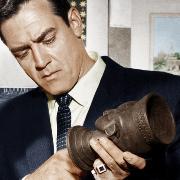(Thread IKs:
sharknado slashfic)
|
This article is an absolute must read. It's from 1977 in The Atlantic about the viking landers life experiments on Mars. Read this and then tell me with a straight face we didn't find life on Mars all the way back then. Both landers ran 3 different experiments as well as controls multiple times and every test showed positive results. It's absolutely ridiculous that NASA was too chickenshit to announce life on Mars as a result and I weep to think what might have been in our space program had they done so. https://www.theatlantic.com/magazine/archive/1977/06/life-on-mars/307391/ quote:All of the life-seeking tests showed reactions, which, says Dr. Levin, "if we had seen them on earth, would unhesitatingly have described as biological. All of them have been confirmed by control experiments. All of them have been successfully repeated at both of the Viking landing sites.
|
|
|
|
|

|
| # ? Jun 8, 2024 11:23 |
|
D-Pad posted:This article is an absolute must read. It's from 1977 in The Atlantic about the viking landers life experiments on Mars. Read this and then tell me with a straight face we didn't find life on Mars all the way back then. Both landers ran 3 different experiments as well as controls multiple times and every test showed positive results. It's absolutely ridiculous that NASA was too chickenshit to announce life on Mars as a result and I weep to think what might have been in our space program had they done so. the atlantic used to be so good...
|
|
|
|
Thanks for that write up, klingon w bowl cut! Does anyone know when and where people first talked about the greys being emotion vampires/feeders? Another recent example that pops into my head is Steven Erikson's "Rejoice" novel where he has the greys straight up torturing humans to feed on their fear. Fire in the Sky as well I think? Turpitude has issued a correction as of 18:36 on Jan 17, 2024 |
|
|
LITERALLY A BIRD posted:
totally agree 
|
|
|
|
|
D-Pad posted:This article is an absolute must read. It's from 1977 in The Atlantic about the viking landers life experiments on Mars. Read this and then tell me with a straight face we didn't find life on Mars all the way back then. Both landers ran 3 different experiments as well as controls multiple times and every test showed positive results. It's absolutely ridiculous that NASA was too chickenshit to announce life on Mars as a result and I weep to think what might have been in our space program had they done so. I got paywalled, but how did they control for contamination? I just watched a recent Mars rover documentary, and it seemed like they were still figuring out how to keep equipment sufficiently sterile given that even our cleanest air and materials are still full of potential contaminants.
|
|
|
Fitzy Fitz posted:I got paywalled, but how did they control for contamination? I just watched a recent Mars rover documentary, and it seemed like they were still figuring out how to keep equipment sufficiently sterile given that even our cleanest air and materials are still full of potential contaminants. Full article for paywall: quote:The idea that Mars, like the earth, might be the home of living beings has held our imagination since the turn of the century, when Percival Lowell thought he saw hundreds of canals crisscrossing the face of the planet, and took them as proof that Mars was inhabited.
|
|
|
|
|
Mars is pretty dead. if there's anything living there it'd kick our asses and wear our skins as decorative hats.
|
|
|
coconono posted:Mars is pretty dead. if there's anything living there it'd kick our asses and wear our skins as decorative hats. since it doesn't have a magnetosphere it's not likely to have any surface life, but it used to have one so there could potentially be soil bacteria or something else living deep enough below ground where they'd be safe from radiation. and maybe soil bacteria could kick our rear end, idk
|
|
|
|
|
D-Pad posted:Full article for paywall: thank you 🙏 quote:At the same time, a substantial "greenhouse effect" would occur, in which the warmth of the sun would trapped by the atmosphere faster than it could dissipate again into space, and the temperature of the entire planet would be raised—according to Sagan's calculations, perhaps by 60 degrees or more. The net result of all this would be a very comfortable, Earth-like planet, capable of supporting an array of familiar creatures. Indeed, if Sagan's reconstruction is correct, during these warmer epochs of Martian climate, a man might have been able to walk around on Mars in his shirtsleeves in perfect comfort. comedy option: the ufos we see on earth really are just ancient martians, as if we've been living in a bad sci fi movie from the 60s
|
|
|
|
Hatebag posted:since it doesn't have a magnetosphere it's not likely to have any surface life, but it used to have one so there could potentially be soil bacteria or something else living deep enough below ground where they'd be safe from radiation. you put corn in the ground, the bacteria gets into the corn, now the corn is kicking our rear end. I've seen all the movies.
|
|
|
|
coconono posted:you put corn in the ground, the bacteria gets into the corn, now the corn is kicking our rear end. I've seen all the movies. then you should know that even the weakest earthling could beat up the giant apes who live there. mars is for wimps
|
|
|
|
aw frig aw dang it posted:then you should know that even the weakest earthling could beat up the giant apes who live there. mars is for wimps Get on that rocket and show your work, homie.
|
|
|
|
Polo-Rican posted:comedy option: the ufos we see on earth really are just ancient martians, as if we've been living in a bad sci fi movie from the 60s Cydonia ain't going away!!
|
|
|
coconono posted:Mars is pretty dead. if there's anything living there it'd kick our asses and wear our skins as decorative hats. one of my favorite dreams was where mars, the god, had a feminine aspect i was hanging out with, and she took me back to a previous cycle in the eternal reocurrence, where humans were colonizing mars. This was, for a lot of reasons, deeply upsetting to them, and a fool rear end move on the part of the humans. I joined her in acting out/similuating the scene, joyously de-orbiting small satelites and debris and watching it rain down on the settlement. Mars was extremely dead in the sense that there's no corporeal life there to speak of, and it was not welcome there either. I can't justify it in human terms, but it was a good thing somehow, i knew this in the moment. The mars masculine aspect was there too, but he was like the actual historical depictions of Aries - kind of insane and kind of a bummer; he didn't like me but he respected the other aspect too much to gently caress with me. Anyway it was joyous to throw asteroids. My dreams are so cool y'all
|
|
|
|
Hatebag posted:since it doesn't have a magnetosphere it's not likely to have any surface life, but it used to have one so there could potentially be soil bacteria or something else living deep enough below ground where they'd be safe from radiation. I think it's pretty likely there's subsurface bacteria but it probably isn't ubiquitous across the planet anymore. Most probable hypothesis seems to be that organic waste material is re-consumed fast enough that it doesn't pile up, which could make sense in an environment with extremely limited resources
|
|
|
|
|
I remote viewed the Martian hollow earth (also known as Hollow Mars) and it was full of bacteria
|
|
|
mdemone posted:I think it's pretty likely there's subsurface bacteria but it probably isn't ubiquitous across the planet anymore. another thing to consider would be caves, lava tubes, etc. those could certainly contain life as well. on earth, soil bacteria concentration drops off with depth, so the top 20 cm or so has a large portion of the bacteria. on mars, they'd have to be like a meter deep or so to be protected. plus they'd be completely dependent on groundwater, and since there's no rain the water table could be pretty far from the surface. they need to send a drilling robot to mars, those little guys could be 100 meters deep! hell, they could be in aquifers. i suppose sending a drill rig and having a robot assemble it would be a bit of a challenge. wait, they should build that nuclear powered drilling machine and send it to mars! brilliant!
|
|
|
|
|
Riot Bimbo posted:My dreams are so cool y'all I'm jealous. I rarely dream!
|
|
|
|
I do drugs specifically to not dream. Mostly because I dream about getting ripped apart by giant insects or crawling through barbed wire.
|
|
|
|

|
|
|
|
psh tried, why would you say no to a tall hairy dude that wants to eat your rear end
|
|
|
|
i woke up a night or two ago and looked towards the door and said "mhm" audibly because i heard a voice, can't remember what it said tho immediately after i called myself a dumbass 
|
|
|
|
my bony fealty posted:I tried listening to Astonishing Legends and for a podcast that's 2 hours long there was like maybe an hour of content gah those guys have to be 2 of the most unfunny people on the planet try otherworld, especially episodes 6, 14, 26, 33, 34, 36, 65. haunted road is a good one - ghost investigations and the history of a haunted location. episodes about ww2 ships are good ones. uncanny by danny robins - bbc quality ghost tales and such. fun listen try those to wet your beak
|
|
|
coconono posted:I do drugs specifically to not dream. Mostly because I dream about getting ripped apart by giant insects or crawling through barbed wire. mine is the thing where I can't move except very slowly, it's super painful and almost impossible to move, but I really really gotta do something because something is happening and I gotta move so I do the drugs too.
|
|
|
|
|
Had a good run but dreams are getting more and more unpleasant with greater frequency. Still not gonna smoke but it needs to stop
|
|
|
|
Have your spouse pummel you awake during nightmares It works for me
|
|
|
|
I did whole sleep studies, which they had to interrupt because they were afraid I'd break their equipment. And I'm thrashing in my sleep so that's ruined anything sleepsnuggle related because I turn into a "supine vortex of screaming elbows and feet". I sidekicked a vase off the bedstand one night, I was told my form was excellent. Even talked to therapists, who suggested stuff like quitting nicotine and caffeine(which has been pretty nice! I can smell things and I'm not angry all the time). Even stopped smoking weed for a while, which made my dreams 1000x more gorey/gonzo(I'm Matt Damon in blackhawk down and Somalia has been invaded by insects with boar's heads). Maybe I'm this way because Aitee did something to me. Or maybe I'm just a lifetime of mundane human traumas my dreamside is being overly dramatic about. So instead I get a little smoke(if I smoke too much I just stay up all night watching dudes disassemble cars) in my system, read whatever wh40k novel I'm dinking through, fall asleep and wake up pretty refreshed in the morning. I don't envy people who dream, because it is what it is. When I do dream about nice stuff its pretty fun. But usually those are dreams where I build stuff. So I wake up wanting to build such things. Sometimes I do. Sometimes I find out the costs of hydraulics and electric motors fare exceeds my humble means.
|
|
|
|
coconono posted:I do drugs specifically to not dream. Mostly because I dream about getting ripped apart by giant insects or crawling through barbed wire. lol same tho i found you eventually start dreaming again no matter how much you weed for instance
|
|
|
|
Yeah I definitely did dream while smoking. Even lucid dreams, vivid nightmares, the works. Just didn't dream every night and dreamt less vividly more often.
|
|
|
|
My dad moved to a place that has an annual sasquatch festival and I asked him to give me a heads up when it's coming so I can go this year. Hell yeah sasquatch
|
|
|
|
https://www.liberationtimes.com/hom...non-human-craft Jeremy Corbell Affirms: U.S. Government and Defense Contractors Hold "Multiple Undamaged, Functional Non-Human Craft" quote:Corbell commented:
|
|
|
|
seems fishy to me because nato weapons are garbage maybe they aren’t having any success with it
|
|
|
|
I love hearing about y’all’s dreams. Mine are boring or weird by comparison. A recurring one I had as a child: I walked into the kitchen and saw that the window curtains had been pulled down and draped over the table. I asked my mom: “what happens when curtains are put on a table?” I don’t remember her response, but I remember standing across the kitchen staring at the purple curtains covering the table, only lit by the pale white of the kitchen light that is connected to the room with the table. I felt like there was something concerning about the curtains on the table and had a sense of dread. Then, the curtains started to rise up off the table and take a form, similar to but not the same as the kind pterodactyl lady I mentioned from another dream, but this one was malevolent- and it darts toward me off the table as I wake up.
|
|
|
|
how would they have undamaged craft anyway? that's stupid, setting aside the fact that american weapons weren't good enough to beat the taliban
|
|
|
|
coconono posted:Even stopped smoking weed for a while, which made my dreams 1000x more gorey/gonzo(I'm Matt Damon in blackhawk down and Somalia has been invaded by insects with boar's heads). Maybe I'm this way because Aitee did something to me. Or Or quote:read whatever wh40k novel I'm dinking through, fall asleep and wake up pretty refreshed in the morning. Maybe the problem is your are seeding your dreams with your desire for the golden throne? IDK Lately, like over the past couple of years, I've been having dreams in which I am providing information on a variety of subjects to some off camera audience. Details of US politics, differences from Canadian politics, other topics like that. I also feel like I am being put into situations of violence in order to test my reaction to these scenarios. So, for instance, last night I had a dream some nude crazy nazi (who I also felt was a cop) was beating this homeless guy horribly, and then took his belongings and his dog. So, of course, I followed them into a shop (felt like an Army-Navy surplus store) in which I encountered the now clothed individual who brandished a baseball bat at me. I was then told I had a bat in my own roller bag (which suddenly appeared--nice silvery hard shelled carryon, should look into getting one). His was wood, mine turned out to be aluminum. SO then I was asked by someone off camera "so how do you deal with him? Brain him?" and I woke up still tapping his fingers telling him to "drop it". Weird. Should the aliens invade I hope to get a good bat I guess?
|
|
|
|
|
Hatebag posted:how would they have undamaged craft anyway? that's stupid, setting aside the fact that american weapons weren't good enough to beat the taliban We did beat the Taliban. They ran away. Its just we didn't follow up with societal modifications and infrastructure improvements that would have kept them out. When it comes to blowing poo poo up, US and NATO have that really well figured out. Now blowing the right stuff up the right amount, that's another story. Or keeping the amenable locals from getting eaten by said explosions.
|
|
|
|
LuckyCat posted:I love hearing about y’all’s dreams. Mine are boring or weird by comparison. lmao I literally read this and went what, strong disagree, this is the person with the pterodactyl dream! and was pleased to read the rest of your post LuckyCat posted:A recurring one I had as a child: I walked into the kitchen and saw that the window curtains had been pulled down and draped over the table. I asked my mom: “what happens when curtains are put on a table?” Pterodactyl lady felt like a Person, when you told us about her. I liked that 
|
|
|
|
coconono posted:We did beat the Taliban. hmmm. really ?
|
|
|
|
Hatebag posted:how would they have undamaged craft anyway? that's stupid, setting aside the fact that american weapons weren't good enough to beat the taliban lol i can't remember who mentioned it, but someone told a story once of how the military or whoever tracked a ufo and for some reason it landed... the occupants got out of the craft and an extraction team came in and scooped it before the occupants came back.
|
|
|
|

|
| # ? Jun 8, 2024 11:23 |
|
maybe you were fake posting sorry
|
|
|


























